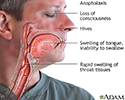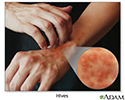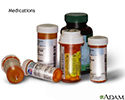Drug allergies
Allergic reaction - drug (medication); Drug hypersensitivity; Medication hypersensitivity
Drug allergies are a group of symptoms caused by an allergic reaction to a drug (medicine).
Causes
A drug allergy involves an immune response in the body that produces an allergic reaction to a medicine.
Allergic reaction
Allergic reactions are sensitivities to substances called allergens that come into contact with the skin, nose, eyes, respiratory tract, and gastroin...

The first time you take the medicine, you may have no problems. But, your body's immune system may produce a substance (antibody) against that drug. The next time you take the drug, the antibody may tell your white blood cells to make a chemical called histamine. Histamines and other chemicals cause your allergy symptoms.
Common allergy-causing drugs include:
Allergy-causing
An allergen is a substance that can cause an allergic reaction. In some people, the immune system recognizes allergens as foreign or dangerous. As ...

- Drugs used to treat seizures
- Insulin (especially animal sources of insulin)
- Substances containing iodine, such as x-ray contrast dyes (these can cause allergy-like reactions)
- Penicillin and related antibiotics
- Sulfa drugs
Most side effects of drugs are not due to an allergic reaction. For example, aspirin can cause hives or trigger asthma without involving the immune system. Many people confuse an unpleasant, but not serious, side effect of a medicine (such as nausea) with a drug allergy.
Hives
Hives are raised, often itchy, red bumps (welts) on the surface of the skin. They are usually an allergic reaction to food or medicine. They can al...

Asthma
Asthma is a disease that causes the airways of the lungs to swell and narrow. It leads to wheezing, shortness of breath, chest tightness, and coughi...

Symptoms
Most drug allergies cause minor skin rashes and hives. These symptoms may occur right away or hours after receiving the drug. Serum sickness is a delayed type of drug allergy that occurs a week or more after you are exposed to a medicine or vaccine.
Serum sickness
Serum sickness is a reaction that is similar to an allergy. The immune system reacts to medicines that contain proteins used to treat immune conditi...

Common symptoms of a drug allergy include:
- Hives
- Itching of the skin or eyes (common)
-
Skin rash
(common)
Skin rash
Rashes involve changes in the color, feeling or texture of your skin.
 ImageRead Article Now Book Mark Article
ImageRead Article Now Book Mark Article -
Swelling
of the lips, tongue, or face
Swelling
Swelling is the enlargement of organs, skin, or other body parts. It is caused by a buildup of fluid in the tissues. The extra fluid can lead to a ...
 ImageRead Article Now Book Mark Article
ImageRead Article Now Book Mark Article -
Wheezing
Wheezing
Wheezing is a high-pitched whistling sound during breathing. It occurs when air moves through narrowed breathing tubes in the lungs.
 ImageRead Article Now Book Mark Article
ImageRead Article Now Book Mark Article
Symptoms of anaphylaxis include:
-
Abdominal pain
or cramping
Abdominal pain
Abdominal pain is pain that you feel anywhere between your chest and groin. This is often referred to as the stomach region or belly.
 ImageRead Article Now Book Mark Article
ImageRead Article Now Book Mark Article -
Confusion
Confusion
Confusion is the inability to think as clearly or quickly as you normally do. You may feel disoriented and have difficulty paying attention, remembe...
 ImageRead Article Now Book Mark Article
ImageRead Article Now Book Mark Article - Diarrhea
-
Difficulty breathing
with wheezing or hoarse voice
Difficulty breathing
Breathing difficulty may involve:Difficult breathingUncomfortable breathingFeeling like you are not getting enough air
 ImageRead Article Now Book Mark Article
ImageRead Article Now Book Mark Article -
Dizziness
Dizziness
Dizziness is a term that is often used to describe 2 different symptoms: lightheadedness and vertigo. Lightheadedness is a feeling that you might fai...
 ImageRead Article Now Book Mark Article
ImageRead Article Now Book Mark Article -
Fainting
, lightheadedness
Fainting
Fainting is a brief loss of consciousness due to a drop in blood flow to the brain. The episode most often lasts less than a couple of minutes and y...
Read Article Now Book Mark Article - Hives over different parts of the body
- Nausea, vomiting
-
Rapid pulse
Rapid pulse
A bounding pulse is a strong throbbing felt over one of the arteries in the body. It is due to a forceful heartbeat.
 ImageRead Article Now Book Mark Article
ImageRead Article Now Book Mark Article -
Sensation of feeling the heart beat (
palpitations
)
Palpitations
Palpitations are feelings or sensations that your heart is pounding or racing. They can be felt in your chest, throat, or neck. You may:Have an unpl...
 ImageRead Article Now Book Mark Article
ImageRead Article Now Book Mark Article
Exams and Tests
An examination may show:
- Decreased blood pressure
- Hives
- Rash
-
Swelling of the lips, face, or tongue (
angioedema
)
Angioedema
Angioedema is swelling that is similar to hives, but the swelling is under the skin instead of on the surface. Hives are often called welts. They a...
Read Article Now Book Mark Article - Wheezing
Skin testing may help diagnose an allergy to penicillin-type medicines. There are no good skin or blood tests to help diagnose other drug allergies.
If you have had allergy-like symptoms after taking a medicine or receiving contrast (dye) before getting an x-ray, your health care provider will often tell you that this is proof of a drug allergy. You do not need more testing.
Treatment
The goal of treatment is to relieve symptoms and prevent a severe reaction.
Treatment may include:
- Antihistamines to relieve mild symptoms such as rash, hives, and itching
- Bronchodilators such as albuterol to reduce asthma-like symptoms (moderate wheezing or cough)
- Corticosteroids applied to the skin, given by mouth, or given through a vein (intravenously)
- Epinephrine by injection to treat anaphylaxis
The offending medicine and similar drugs should be avoided. Make sure all your providers -- including dentists and hospital staff -- know about any drug allergies that you or your children have.
In some cases, a penicillin (or other drug) allergy responds to desensitization. This treatment involves being given very small doses at first, followed by larger and larger doses of a medicine to improve your tolerance of the drug. This process should be done only by an allergist, when there is no alternative drug for you to take.
Outlook (Prognosis)
Most drug allergies respond to treatment. But sometimes, they can lead to severe asthma, anaphylaxis, or death.
When to Contact a Medical Professional
Call your provider if you are taking a medicine and seem to be having a reaction to it.
Go to the emergency room or call the local emergency number (such as 911) if you have difficulty breathing or develop other symptoms of severe asthma or anaphylaxis. These are emergency conditions.
Prevention
There is generally no way to prevent a drug allergy.
If you have a known drug allergy, avoiding the drug is the best way to prevent an allergic reaction. You may also be told to avoid similar medicines.
In some cases, a provider may approve the use of a drug that causes an allergy if you are first treated with medicines that slow or block the immune response. These include corticosteroids (such as prednisone) and antihistamines. Do not try this without a provider's supervision. Pretreatment with corticosteroids and antihistamines has been shown to prevent allergic reactions in people who need to get x-ray contrast dye.
Your provider may also recommend densensitization.
References
Celik G, Pichler WJ, Adkinson NF Jr. Drug allergy. In: Adkinson NF Jr, Bochner BS, Burks AW, et al, eds. Middleton's Allergy: Principles and Practice . 8th ed. Philadelphia, PA: Elsevier Saunders; 2014:chap 79.
Grammer LC. Drug allergy. In: Goldman L, Schafer AI, eds. Goldman's Cecil Medicine . 25th ed. Philadelphia, PA: Elsevier Saunders; 2016:chap 254.
Tran TP, Muelleman RL. Allergy, hypersensitivity, angioedema, and anaphylaxis. In: Marx JA, Hockberger RS, Walls RM, et al, eds. Rosen's Emergency Medicine: Concepts and Clinical Practice . 8th ed. Philadelphia, PA: Elsevier Saunders; 2014:chap 119.
-
Anaphylaxis - illustration
Anaphylaxis is an acute systemic (whole body) type of allergic reaction which occurs when a person has become sensitized to a certain substance or allergen and is again exposed to the allergen. Some drugs, such as those used for pain relief or for x-rays, may cause an anaphylactoid reaction on first exposure. Histamines and other substances released into the bloodstream cause blood vessels to dilate and tissues to swell. Anaphylaxis may be life threatening if obstruction of the airway occurs, if blood pressure drops, or if heart arrhythmias occur.
Anaphylaxis
illustration
-
Hives - illustration
Hives are raised red welts of various size on the surface of the skin, often itchy, which come and go. Also called urticaria, hives is usually part of an allergic reaction to drugs or food. The term "dermatitis" describes an inflammatory response of the skin, caused by contact with allergens or irritants, exposure to sunlight, or by poor circulation, even stress. AVOID SCRATCHING. Scratching the rash may spread the inflammation, lead to infection and even leave scars.
Hives
illustration
-
Allergic reactions to medication - illustration
A true allergy to a medication is different than a simple adverse reaction to the drug. The allergic reaction occurs when the immune system, having been exposed to the drug before, creates antibodies to it. On subsequent exposure to the drug these antibodies cause release of histamines. If severe, this reaction can result in a life-threatening situation known as anaphylactic shock.
Allergic reactions to medication
illustration
-
Dermatitis, contact - illustration
This picture shows a skin inflammation (dermatitis) caused by contact with a material that causes an allergic reaction in this person. Contact dermatitis is a relatively common condition, and can be caused by many substances.
Dermatitis, contact
illustration
-
Dermatitis, pustular contact - illustration
This is a close-up of a dermatitis reaction. It consists of a large, red (erythematous) lesion (plaque) with numerous small pus-filled areas (pustules).
Dermatitis, pustular contact
illustration
-
Drug rash, Tegretol - illustration
This drug rash was caused by Tegretol. Medications can cause many different skin reactions, with varying rashes.
Drug rash, Tegretol
illustration
-
Fixed drug eruption - illustration
Medications can cause many skin reactions. This particular appearance is called a "fixed drug eruption" and was caused by a reaction to ceftazidime. This type of reaction typically recurs in exactly the same location when the person takes the same medication again.
Fixed drug eruption
illustration
-
Fixed drug eruption, bullous - illustration
Medications can cause many different types of skin reactions. This particular appearance is called a "fixed drug eruption". This type of reaction typically happens in the same location when the person uses the same medication again.
Fixed drug eruption, bullous
illustration
-
Fixed drug eruption on the cheek - illustration
Medications can cause many skin reactions. This particular rash, seen here on the cheek, is called a "fixed drug eruption". This type of reaction typically occurs in the same location when the person uses the same medication again.
Fixed drug eruption on the cheek
illustration
-
Drug rash on the back - illustration
Many medications may produce allergic rashes. This individual has had an allergic reaction to ampicillin.
Drug rash on the back
illustration
-
Antibodies - illustration
Antigens are large molecules (usually proteins) on the surface of cells, viruses, fungi, bacteria, and some non-living substances such as toxins, chemicals, drugs, and foreign particles. The immune system recognizes antigens and produces antibodies that destroy substances containing antigens.
Antibodies
illustration
-
Anaphylaxis - illustration
Anaphylaxis is an acute systemic (whole body) type of allergic reaction which occurs when a person has become sensitized to a certain substance or allergen and is again exposed to the allergen. Some drugs, such as those used for pain relief or for x-rays, may cause an anaphylactoid reaction on first exposure. Histamines and other substances released into the bloodstream cause blood vessels to dilate and tissues to swell. Anaphylaxis may be life threatening if obstruction of the airway occurs, if blood pressure drops, or if heart arrhythmias occur.
Anaphylaxis
illustration
-
Hives - illustration
Hives are raised red welts of various size on the surface of the skin, often itchy, which come and go. Also called urticaria, hives is usually part of an allergic reaction to drugs or food. The term "dermatitis" describes an inflammatory response of the skin, caused by contact with allergens or irritants, exposure to sunlight, or by poor circulation, even stress. AVOID SCRATCHING. Scratching the rash may spread the inflammation, lead to infection and even leave scars.
Hives
illustration
-
Allergic reactions to medication - illustration
A true allergy to a medication is different than a simple adverse reaction to the drug. The allergic reaction occurs when the immune system, having been exposed to the drug before, creates antibodies to it. On subsequent exposure to the drug these antibodies cause release of histamines. If severe, this reaction can result in a life-threatening situation known as anaphylactic shock.
Allergic reactions to medication
illustration
-
Dermatitis, contact - illustration
This picture shows a skin inflammation (dermatitis) caused by contact with a material that causes an allergic reaction in this person. Contact dermatitis is a relatively common condition, and can be caused by many substances.
Dermatitis, contact
illustration
-
Dermatitis, pustular contact - illustration
This is a close-up of a dermatitis reaction. It consists of a large, red (erythematous) lesion (plaque) with numerous small pus-filled areas (pustules).
Dermatitis, pustular contact
illustration
-
Drug rash, Tegretol - illustration
This drug rash was caused by Tegretol. Medications can cause many different skin reactions, with varying rashes.
Drug rash, Tegretol
illustration
-
Fixed drug eruption - illustration
Medications can cause many skin reactions. This particular appearance is called a "fixed drug eruption" and was caused by a reaction to ceftazidime. This type of reaction typically recurs in exactly the same location when the person takes the same medication again.
Fixed drug eruption
illustration
-
Fixed drug eruption, bullous - illustration
Medications can cause many different types of skin reactions. This particular appearance is called a "fixed drug eruption". This type of reaction typically happens in the same location when the person uses the same medication again.
Fixed drug eruption, bullous
illustration
-
Fixed drug eruption on the cheek - illustration
Medications can cause many skin reactions. This particular rash, seen here on the cheek, is called a "fixed drug eruption". This type of reaction typically occurs in the same location when the person uses the same medication again.
Fixed drug eruption on the cheek
illustration
-
Drug rash on the back - illustration
Many medications may produce allergic rashes. This individual has had an allergic reaction to ampicillin.
Drug rash on the back
illustration
-
Antibodies - illustration
Antigens are large molecules (usually proteins) on the surface of cells, viruses, fungi, bacteria, and some non-living substances such as toxins, chemicals, drugs, and foreign particles. The immune system recognizes antigens and produces antibodies that destroy substances containing antigens.
Antibodies
illustration
Review Date: 3/14/2016
Reviewed By: Stuart I. Henochowicz, MD, FACP, Associate Clinical Professor of Medicine, Division of Allergy, Immunology, and Rheumatology, Georgetown University Medical School, Washington, DC. Also reviewed by David Zieve, MD, MHA, Isla Ogilvie, PhD, and the A.D.A.M. Editorial team.











